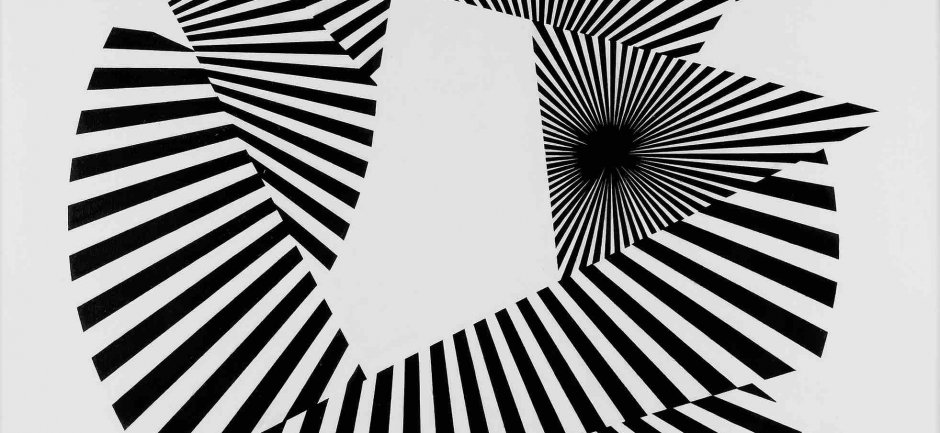Franco Grignani: 1 June – 28 July 2017
Featuring around 20 paintings from the 1950s through to the 1970s, the exhibition provides a survey of Grignani’s work and stylistic developments during this period. A versatile artist and one of the leading early practitioners of Op Art in Italy and a master of Italian post-war graphic design, he began his career as an architect before branching into graphic design, photography and painting. Although he held a position as Art Director for the influential Milanese lifestyle magazine Bellezza d’Italia throughout the 1950s, where his iconic and distorted Futurist-inspired typography and cover designs brought him to international attention, his personal practice remained steeped in the visual processes of optical painting. While still best known for the iconic swirling ‘Pure Virgin Wool’ international logo that he created in 1963, Grignani – alongside his contemporary Victor Vasarely – was one of the earliest precursors of international Op Art – and the work of associated artists such as Bridget Riley, François Morellet, Carlos Cruz-Diez and Jesús Rafael Soto – by several years.
Grignani’s conviction that art could not be separated from other cognitive functions can be traced back to the influence that ideas advocated by Walter Gropius and other teachers at the Bauhaus exerted on him. Following these principles, he dedicated over three decades of his artistic career to the study of the principles of visual perception. Oscillating between the worlds of visual art and graphic design, Grignani introduced elements of industrial production into his works. Works from the early 1950s, such as Ordine ascensionale (1952), use textured industrial glass superimposed over graphic drawings to obtain a “blurred” effect. Grignani was also the first to widely use emulsified canvas in experimental pieces such as Combinatoria di strutture ondulate interferenti (1956), in which the introduction of a moiré photographic pattern stamped directly on to the canvas serves to heighten the optical vibrations. These are an antithesis to the ‘expressionism’ and gestural tendencies of l’art informel that was prevalent during the 1950s, and Grignani’s research and interests very much isolated him from the aesthetic trends du jour. Yet these same industrial materials would become a stalwart of Op, Kinetic and Programmed art just a few years later.
The paintings in the exhibition are emblematic of Grignani’s experiments in which he carefully analysed the sensations of vision and boundaries of perception, harnessing optical illusion to animate static geometric forms and incite psychological responses in the viewer. His works are informed by Gestalt psychologie, otherwise known as the ‘Law of Simplicity’, where objects and images are reduced to their simplest forms. He focused on distortion as the reproduction of a hyperbolic world antithetic to human sight. As a result, paintings like Frammentazione radiale (1964) are pared down to simple black-and-white graphic shapes, which strip away unnecessary detail and draw sharp attention to the way in which the stripes criss-cross, radiate and refract from each other. Dissociazione dal bordo (93) (1967), in the meantime, is one of the first paintings by Grignani to include the use of colour and, with its curving ribbon-like form, a playful antidote to the clean structures of works from the 1950s.
With work in the collections of the Museum of Modern Art (New York), the Stedelijk Museum (Amsterdam), the Museum of Modern Art (Warsaw), and the Victoria and Albert Museum (London), the exhibition is a rigorous introduction to one of Italy’s most innovative artists and designers.
The exhibition will be accompanied by a fully illustrated catalogue with an introduction by Serge Lemoine, former President of the Musée d’Orsay, Paris.
The Estorick Collection will also present a solo exhibition of Franco Grignani’s graphic work and paintings from 5 July through to 10 September. Entitled Franco Grignani: Art as Design 1950-1990, the exhibition comprises graphic design projects and 130 paintings and works on paper, many of which are from the Grignani family collection, introducing UK audiences to the work of an artistic pioneer whose achievements have tended to be overshadowed by figures such as Bridget Riley.
Contacts
For further press information please contact Anya Harrison at Kallaway PR
anya.harrison@kallaway.com | mlfineart@kallaway.com
+44 (0)20 7221 7883
M&L Fine Art
Olimpia Grassi
+44 (0)20 7493 1971
Notes to Editors
About M&L Fine Art
M&L Fine Art specialises in Modern and Contemporary art with a focus on Italian artists such as Carla Accardi, Mario Balloco, Agostino Bonalumi, Antonio Calderara, Enrico Castellani, Lucio Fontana, Leoncillo, Piero Manzoni, Giulio Paolini, Angelo Savelli and Salvatore Scarpitta. The gallery is located in the heart of London’s historical art market district on Old Bond Street and provides an international platform for the artists represented.
Founded in October 2015, M&L Fine Art is a partnership between Matteo Lampertico and Luca Gracis.
Franco Grignani: Art as Design 1950-1990 at the Estorick Collection
A further exhibition of Franco Grignani’s graphic work and paintings will run at the Estorick Collection of Modern Italian Art, 39a Canonbury Square, London N1 2AN. More details at www.estorickcollection.com. Press information about the Estorick Collection from alison@alisonwrightpr.com

